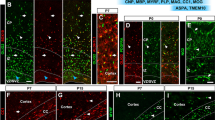Summary
Autoradiographs of tritiated thymidine uptake and subsequent light- and electron-microscopical examination revealed an onset of perineurial glial cell proliferation 3 days after injury to the CNS. The number of cells labelled increased rapidly until 7 days post-lesioning. At 2 weeks, the labelled cells equalled the number of nuclei present in the perineurium. No label was seen in the subperineurial cells, possibly because of the inability of the label to penetrate into a region where localised division is taking place.
Prior to the onset of thymidine uptake, the damaged nerve cord was invaded by an exogenous reactive cell. The number of these cells increased rapidly in the first 48 h, then decreased as a negative exponential, very few remaining after 7 days. We suggest that this cell type must either return to the haemocoel or transform into a functional glial cell class.
The repair of the insect central nervous system can be divided into three phases which show striking similarities to vertebrate repair sequences. These include: initial invasion of the lesion by exogenous cells, subsequent proliferation of glial cells, the longer term flux of cell numbers, their distribution and the time scale of events. This suggests that the insect CNS might provide a system for examining common cellular mechanisms and events.
Similar content being viewed by others
References
Adrian EK Jr, Schelper RL (1981) Microglia, monocytes and macrophages. In: Vidro EA, Federoff A (eds) Glial and Neuronal Cell Biology, 11th International Congress of Anatomy Part A, AR Liss Inc New York, pp 113–124
Adrian EK Jr, Williams MG, George FC (1978) Fine structure of reactive cells in injured nervous tissue labeled with 3H-thymidine injected before injury. J Comp Neurol 180:815–840
Bennett MD, Smith JB (1976) Nuclear DNA amounts in angiosperms. Phil Trans R Soc Lond [Biol] 274:227–274
Benveniste EN, Merrill JE, Kaufman SE, Golde DW, Gasson JC (1985) Purification and characterization of a human T-lymphocyte-derived glial growth factor. Proc Natl Acad Sci USA 82:3930–3934
Brockes JP (1984) Mitogenic growth factors and nerve dependence of limb regeneration. Science 225:1280–1287
du Bois M, Bowman PD, Goldstein GW (1985) Cell proliferation after ischemic injury in gerbil brain. An immunocytochemical and autoradiographic study. Cell Tissue Res 242:17–23
Fontana A, Grieder A, Arrenbrecht St, Grob P (1980) In vitro stimulation of glial cells by a lymphocyte-produced factor. J Neurol Sci 45:55–62
Fujita SY, Tsuchihashi Y, Kitamura T (1981) Origin, morphology and function of microglia. In: Vidro EA, Federoff A (eds) Glial and Neuronal Cell Biology. AR Liss Inc New York, pp 141–170
Grimstone AV, Skaer RJ (1972) A guidebook to microscopical methods. Camb Univ Press
Guilian D, Baker TJ (1985) Peptides released by ameboid microglia regulate astroglial proliferation. J Cell Biol 101:2411–2415
Guilian D, Tomozawa Y, Hindman H, Allen RL (1985) Peptides from regenerating central nervous system promote specific populations of microglia. Proc Natl Acad Sci USA 82:4287–4290
Howes EA, McLaughlin BJ, Heslop JP (1974) The autoradiographical association of fast transported material with dense core vesicles in the central nervous system of Anodonta cygnea (L.). Cell Tissue Res 153:545–558
Howes EA, Smith PJS, Treherne JE (1986) Glial repair in the cultured central nervous system of an insect. Cell Tissue Res 247:111–120
Imamoto K (1981) Origin of microglia: cell transformation from blood monocytes into macrophagic ameboid cells and microglia. In: Vidro EA, Federoff S (eds) Glial and Neuronal Cell Biology. Alan Liss Inc New York, pp 125–140
Latov N, Nilaver G, Zimmerman EA, Johnson WG, Silverman A, Defendini R, Cote L (1979) Fibrillary astrocytes proliferate in response to brain injury. Dev Biol 72:381–384
Ludwin SK (1984) Proliferation of mature oligodendrocytes after trauma to the central nervous system. Nature 308:274–275
Maddrell SHP, Lane NJ, Harrison JB, Gardiner BOC (1985) DNA replication in binucleate cells of the Malpighian tubules of hemipteran insects. Chromosoma (Berl) 91:201–209
Michler-Stuke A, Bottenstein JE (1982) Proliferation of glial-derived cells in defined media. J Neurosci Res 7:215–228
Morgese VJ, Elliott EJ, Muller KJ (1983) Microglial movement to sites of nerve lesion in the leech CNS. Brain Res 272:166–170
Nieto-Sampedro M, Saneto RP, de Vellis J, Cotman CW (1985) The control of glial populations in brain: Changes in astrocyte mitogenic and morphogenic factors in response to injury. Brain Res 343:320–328
Oger J, Szuchet S, Antel J, Arnason BGW (1982) A monoclonal antibody against human T suppressor lymphocytes binds specifically to the surface of cultured oligodendrocytes. Nature 295:66–68
Raff MC, Miller RH, Noble M (1983) A glial progenitor cell that develops in vitro into an astrocyle or an oligodendrocyte depending on culture medium. Nature 303:390–396
Schofield PK, Treherne JE (1984) Localization of the blood-brain barrier in an insect: electrical model and analysis. J Exp Biol 109:319–331
Smith PJS, Howes EA (1984) Glial toxin effect on protein synthesis in an insect connective. J Cell Sci 70:83–92
Smith PJS, Leech CA, Treherne JE (1984) Glial repair in an insect central nervous system: effects of selective glial disruption. J Neurosci 4(11):2698–2711
Smith PJS, Howes EA, Leech CA, Treherne JE (1986) Haemocyte contribution to glial repair in an insect central nervous system. Cell Tissue Res 243:367–374
Treherne JE, Howes EA, Leech CA, Smith PJS (1986a) The effects of an anti-mytotic drug bleomycin on glial repair in an insect central nervous system. Cell Tissue Res 243:375–384
Treherne JE, Smith PJS, Edwards H (1986b) Neural repair in an insect: Cell recruitment and deployment following selective glial disruption. Cell Tissue Res 247:121–128
Author information
Authors and Affiliations
Rights and permissions
About this article
Cite this article
Smith, P.J.S., Howes, E.A. Neural repair in an insect central nervous system: cell kinetics and proliferation after selective glial disruption. Cell Tissue Res. 247, 129–135 (1987). https://doi.org/10.1007/BF00216555
Accepted:
Issue Date:
DOI: https://doi.org/10.1007/BF00216555




